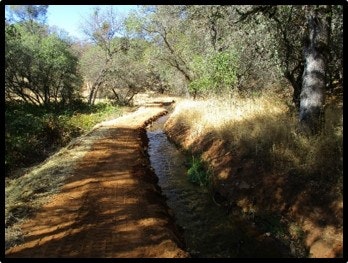Long Term Canopy Cover Study and Tree Health Reports

Assessing Impacts to Vegetation from Changes to Canal Operations
NID constructed the Banner Cascade Pipeline to ensure reliable water deliveries to Grass Valley and Nevada City. These pipelines also serve as the primary means for conveying raw water to Grass Valley and Nevada City and to the Loma Rica and Elizabeth George Treatment Plants. The Banner Cascade Pipeline replaced both the Lower Cascade Canal and the Upper Grass Valley Canal, which had reached capacity and no longer met the needs of the area.
When Banner Cascade Pipeline began operation in the fall of 2013, the flows of the Lower Cascade Canal and the Upper Grass Valley Canal were gradually reduced but will continue to be kept in limited service.
By keeping the canals in service, NID will preserve the canals as a historical, cultural, scenic, and recreational amenity. However, reducing the flows and water levels in these two canals will reduce the wetted perimeter in each canal potentially affecting riparian plants in the immediate area.
The study will assess how the reduced flow will affect canal area vegetation, canopy cover, and associated seep wetlands or ponds.
Long Term Canopy Cover & Pond Study-Baseline Year 0 (2013).pdfLong Term Canopy Cover Study-Tree Health Assessment-Year 2 (2015).pdfLong Term Canopy Cover & Pond Study-Year 4 (2017).pdfLong Term Canopy Cover Study-Tree Health Assessment-Year 6 (2019).pdf
Long Term Canopy Cover, Tree Health Assessment and Pond Study - Year 8
